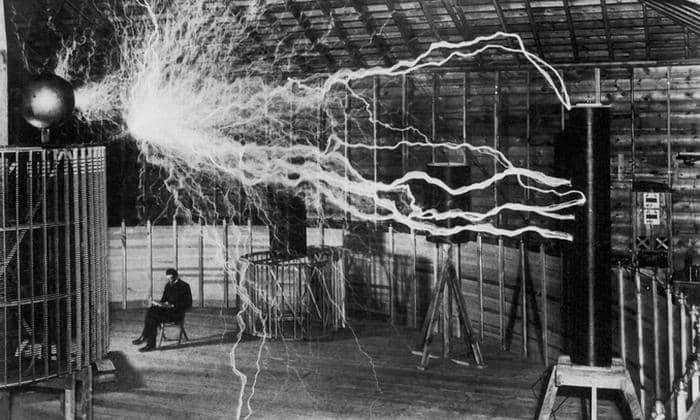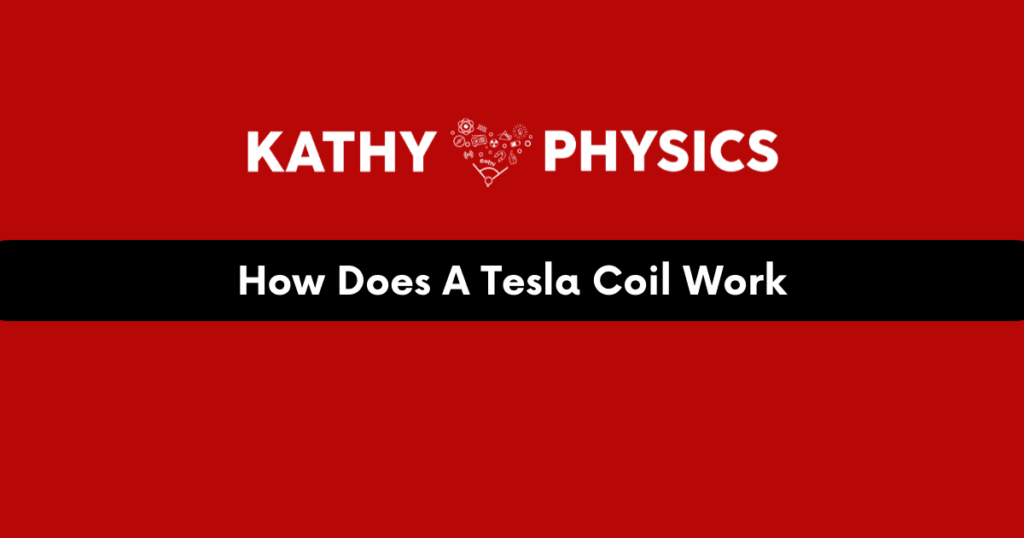You might have seen the crazy cool demonstrations conducted with Tesla coils but how do they actually work? Well, to really answer that question I am going to go talk about how all the parts were discovered and why. Ready for a whirlwind study of electronics?
Table Of Contents
Electromagnet & Induction
The Shocking Irish Priest
The Induction Coil to Hertz’s Radio
Tesla’s Inspiration
How a Modern Tesla Coil Works
Video Script
Electromagnet & Induction
This story begins way back in 1826.
That is when a retired soldier with some pretty amazing sideburns named William Sturgeon discovered that if current runs through coils of wire around an iron bar, the iron bar acts like a magnet and can attract metal.
This was logically called an electromagnet.
Six years later, in 1831, Michael Faraday decided to try to see if he could make electricity with magnets.
He was not having much luck with the weak magnets available at the time, so he decided to play with electromagnets. He had two separate coils wrapped around a single iron ring and found that when he attached or disconnected a battery to the first wire, the second wire would get a jolt of electricity.
Faraday then came up with the idea of magnetic fields and the theory that changing the magnetic field in a coil would create, or induce a current in the wire. Faraday was disappointed, however, that he could never feel the jolt of electricity from the second coil. Remember, electricity was still in its infancy and using themselves as human guinea pigs was one of their few available electrical “devices”.
The Shocking Irish Priest

A few years later an Irish priest and amateur scientist named Nicholas Callan wondered if he could tweak Faraday’s device to make something that might give a “good” shock.
When he wound both coils around the same iron bar (but kept them electrically separate) he could feel the shocks from wires that were not electrically connected to a battery! He then found it was even more impressive when the primary wire (the one connected to the battery) was thick and the secondary coil was really thin and wound around as many times as possible.
Callan didn’t know it, but he had just invented a step-up transformer. See, when he connected a battery to a coil, the coil became an electromagnet with a magnetic field. When he disconnected the battery, the coil lost its magnetic field.
Therefore, according to Faraday’s (brand new) law of induction, every time that Callan connected or disconnected the battery it creates a new current in the secondary coil.
If the secondary coil has fewer loops than the primary than you get more current (but less voltage), which is why Faraday could see the current but could not feel the voltage.
Callan, on the other hand produced a system with far more loops in the secondary coil so he created more voltage (shocks) but also less current.
Callan also created a wheel to mechanically connect and disconnect the battery and was very pleased to note that with just this “repeater”, two coils and an iron bar he created according to him, “the best magneto-electrical machine ever constructed.” Callan sent a report to his friend William Sturgeon (the same guy with the impressive sideburns who had invented the electromagnet in the first place).
Sturgeon and his friend George Bachhoffner made their own versions of Callan’s “machine” (with a better “repeater” and bundles of wires in the core instead of a solid iron bar) and for a while many people made a good fortune selling and demonstrating these torture devices.
The Induction Coil to Hertz’s Radio

The induction coil was incredibly popular, especially for giving “medical” cures: depression, migraines, infertility, fertility, all could be solved with electric shocks!
Now the race was on to produce a bigger and more constant shock or spark.
One of the biggest advancements was using the coil itself to connect and disconnect the primary coil to the battery instead of using a crank that you spun.
See, when there is current in the primary coil it acts like a bar magnet and so the current carrying wire can electrically pull a switch on a spring to turn off the current.
Of course, once the current is removed, the coil no longer acts magnetic, so the switch is then released which causes current to flow in the wires again which pulls on the switch again. These would vibrate around 20 to 40 times every second and was called an electric interrupter!
Unfortunately, the electric interrupter would often spark.
This is why, in 1853, a French physicist named Armand (Hippolyte) Fizau placed something called a Leyden jar or a capacitor next to the interrupter to absorb the spark.
A capacitor is an object with two large metal surfaces that are separated by an insulting material. Leyden jars were the first type of capacitors and are made with coating a glass jar with metal (glass is insulating).
Capacitors can store a large amount of charge on its surface depending on the amount of metal and the thickness of the insulator.
However, by adding a capacitor, Fizau wasn’t just getting rid of an unwanted side spark, he was actually making a totally different device, one that changed direct current from a battery into bursts of oscillating current! How did a jar do that? Let me explain. Imagine you charge a Leyden jar with a battery so that it has an excess of electrons on one side and a deficit on the other.
If the sides are then connected with a wire, the electrons will flow in a burst of current and the jar will become discharged. All well and good. However, imagine that wire has a part that is coiled up, then the burst of current goes through a coil and creates a changing current in a coil.
Changing current in a coil changes the magnetic field in the coil, which induces a new current in the coil (this is called self inductance)! Therefore, when you discharge a capacitor through a coil the current keeps on flowing even after the jar is discharged. The result is that the jar ends up with extra charges in the other orientation.
Eventually, the current stops but then the Leyden jar is charged the other way, and the current begins to flow in the other direction! In a perfect system without resistance, the current will just flow back and forth forever.
However, with resistance, the current goes back and forth getting smaller and smaller with each oscillation until the system is fully discharged with no current flowing. A capacitor connected to a coil is called a tank circuit, and it is used in devices even today when you want the current to oscillate.
The frequency of the oscillation depends on the properties of the capacitor and the coil, so if you want to change the frequency, you can just change the length of the coil or the shape of the capacitor.
In this way, in the 1850s they could use DC from a battery to make bursts of waves oscillating millions of times per second, or oscillating in the radio range.
Of course it took quite a few years for folks to come up with equations and theories for how a tank circuit oscillates and it wasn’t until 1886 that a German scientist named Heinrich Hertz added an antenna to a spark gap generator and created the first human made radio waves! However, Hertz had no interest in industry. He thought that his discovery served no purpose aside from demonstrating that light is an electromagnetic wave.
Tesla’s Inspiration

Now we finally get to Nikola Tesla! Whew! In the summer of 1889, Nikola Tesla went to the World’s fair in Paris and heard about “the miracle” of Hertz’s experiments with radio waves.
Due to these experiments, Tesla began to tinker with the induction coil.
He then had “a happy inspiration” of removing the interrupter and the DC battery and replacing them with an alternating (or AC) generator.
This actually makes perfect sense, why use a battery and a mechanical switch to turn it on and off, when you can use current from a generator that naturally switches from one direction to the other direction? Also, this was after Tesla had just invented the AC motor and 2-phase AC generator so he had AC on the mind so to speak.
He quickly found that the high frequency alternating current in the wires melted the insulation and overheated the iron core. Tesla then realized that he didn’t need the iron and used a gap of air instead.
He then found that the Leyden jars next to the primary coil sometimes worked and sometimes interfered. Therefore, he moved the jars to the secondary circuit and made them variable.
By placing the capacitors in the second circuit he could “tune” the vibration of the coil and capacitor (tank circuit) to a multiple of the frequency of the original alternating current in the primary coil.
In this way, the Tesla coil created extremely high voltage, high frequency alternating current. If Tesla put an antenna on the secondary coil, this would produce very strong and tuned radio waves.
However, Tesla wasn’t really interested in radio waves or wireless communication, he was interested in wireless lighting.
For that reason, Tesla added another resonant electric circuit (new circuit with a set of coils) and could light lamps with a single wire! He then found that neon and florescent tubes would light when they were just held near the coils without any wires at all!
Finally, Tesla found that if he placed a metal tube on the top of his coil it would produce the most beautiful sparks and discharges, which is what a tesla coil is mostly used for today.
How a Modern Tesla Coil Works

So, let me go over how a “modern” tesla coil works and makes a beautiful show.
Remember, if you change the current in one coil, it will create a current in an adjacent coil and if you have more loops you get more voltage (and less current) [transformer]. Also, remember that if you discharge a capacitor through a coil you get oscillating current [tank circuit].
Tesla coils start with the AC from the wall.
Then, they use a step-up transformer (which is made of two parallel coils that increase the voltage and decrease the current). This creates an alternating spark in the spark gap, which causes the primary capacitor to repeatedly charge and discharge, which in resonance with the coils creates high frequency waves [tank circuit].
This high frequency, high voltage current goes through the “primary coil” and induces an even higher voltage, high frequency, super low current in the “secondary coil”. This process can produce millions of volts!
This is so high that the electrons in the air around the coil can become “free” and can transmit electricity (this is called ionizing the air), which allows for a dramatic and LOUD discharge of electricity.
Tesla loved the beautiful demonstrations but he also had a dream to use his coil to electrify the Earth and the atmosphere and make us all glow (which turns out to be physically impossible).
He even convinced J. P. Morgan to fund it! However, a man named Marconi had a more modest goal, to send a wireless telegraph signal across the ocean, and used Tesla’s coil to succeed.

